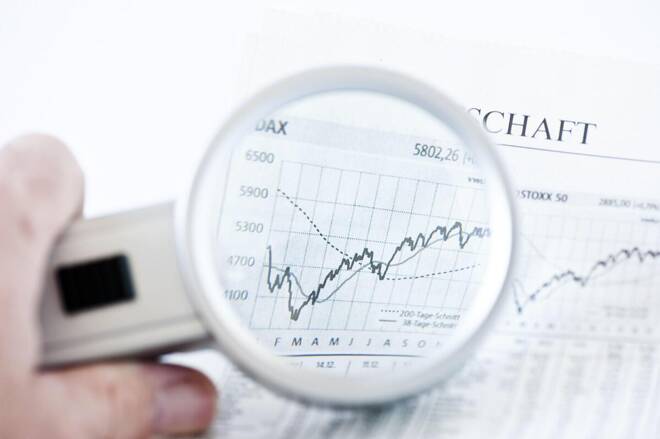Advertisement
Advertisement
DAX Index: Chicago PMI and Central Bank Commentary in Focus
By:
CME FedWatch Tool reports rising March 2024 Fed rate cut probability, while January's chances decline, affecting DAX amid hawkish ECB chatter.
Highlights
- The DAX declined by 0.24% on Thursday, ending the session at 16,702.
- Hawkish ECB commentary left the DAX in negative territory.
- On Friday, central bank chatter and the Chicago PMI are focal points.
Overview of the DAX Performance on Thursday
The DAX declined by 0.24% on Thursday. Reversing a 0.21% gain from Wednesday, the DAX ended the Thursday session at 16,702.
Hawkish ECB Chatter Leaves the DAX in Negative Territory
On Thursday, hawkish ECB chatter countered bets on a Q1 2024 Fed rate cut, impacting DAX-listed stocks.
ECB Governing Council member Robert Holzmann poured cold water on discussions about rate cuts. Holzmann reportedly said,
“Even if the ECB is past an unprecedented series of ten consecutive rate increases, there is also for the year 2024 no guarantee of rate reductions. Monetary policy normalization is already showing its impact on slowing inflation, but it would still be premature to think about rate cuts.”
US Jobless Claims Fail to Deliver Late Support
On Thursday, US jobless claims data reflected a robust US labor market, testing the appetite for riskier assets. Initial jobless claims increased from 206k to 218k in the week ending December 23. Economists forecast claims to rise to 210k.
Despite the uptick, tight US labor market conditions deliver an element of uncertainty about Q1 2024 Fed rate cuts. However, the impact on Q1 Fed rate cut bets, the US equity markets, and the DAX was limited.
According to the CME FedWatch Tool, the probability of a March 2024 Fed rate cut increased from 73.9% to 74.1% on Thursday. However, the chance of a January 2024 Fed rate cut declined from 18.6% to 16.5%. 10-year US Treasury yields increased by 1.21%, ending the session at 3.844%.
The US equity markets had a mixed session. On Thursday, the Dow and the S&P 500 saw gains of 0.14% and 0.04%, respectively. The Nasdaq Composite Index slipped by 0.03%.
The Thursday Market Movers
Auto stocks contributed to the losses. Porsche declined by 0.88%, with Mercedes-Benz Group and Volkswagen falling by 0.65% and 0.57%, respectively. BMW bucked the trend, gaining 0.04%.
Siemens Energy AG was the worst performer, ending the session down 0.97%.
Hawkish ECB chatter impacted rate-sensitive stocks.
US Private Sector in the Spotlight
Later in the European session, Chicago PMI numbers from the US will garner investor interest. Chicago is the third largest by gross metropolitan product (GMP), behind Los Angeles and New York. A marked weakening in private sector activity could raise bets on a Q1 2024 Fed rate cut. However, a slide below 50 could spook investors and reignite fears of a hard landing.
Economists forecast the Chicago PMI to fall from 55.8 to 51.0 in December.
Beyond the numbers, central bank commentary needs monitoring. ECB and Fed chatter regarding inflation, the economy, and interest rates would move the dial.
In the futures, the DAX and Nasdaq mini were up 5 and 8 points, respectively.
Short-Term Forecast
Near-term DAX trends remain hinged on ECB commentary and the US economic calendar. Hawkish ECB forward guidance could counter rising bets on a Q1 2024 Fed rate cut. However, weaker-than-expected US economic data could impact buyer demand for DAX-listed stocks.
DAX Technical Indicators
Daily Chart
The DAX sat above the 50-day and 200-day EMAs, sending bullish price signals.
A DAX move through the 16,750 handle would give the bulls a run at the December 14 ATH 17,003.
Central bank commentary and the Chicago PMI are focal points for the Friday session.
However, a drop below 16,600 would support a fall toward the 16,470 support level.
The 14-day RSI reading of 68.41 suggests a DAX return to 16,800 before entering overbought territory.
4-Hourly Chart
The DAX remained above the 50-day and 200-day EMAs, affirming bullish price signals.
A DAX breakout from 16,750 would support a move toward the December 14 ATH 17,003.
However, a break below the 16,650 handle would give the bears a run at the 50-day EMA.
The 50.31 14-4 hour RSI suggests a DAX return to the 16,850 handle before entering overbought territory.
For a look at the economic events, check out our economic calendar.
About the Author
Bob Masonauthor
With over 28 years of experience in the financial industry, Bob has worked with various global rating agencies and multinational banks. Currently he is covering currencies, commodities, alternative asset classes and global equities, focusing mostly on European and Asian markets.
Advertisement
